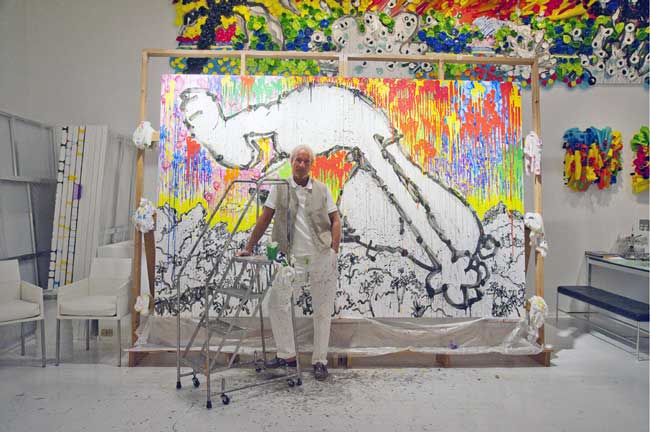 Tom Everhart, the artist who found fame by creating fine art versions of Charles Schulz's iconic "Peanuts" characters, will be opening a new exhibit at the AFA gallery in New York City entitled "Rollin With The Homies." The exhibition, which will run from May 18 through June 18, will feature new pieces by the renowned painter available for viewing and acquisition. Everhart studied art and architecture at Yale University, finishing in 1976 and continuing his post-graduate studies at the Musée de l'Orangerie in Paris. Most of his professional life, however, has been devoted to the emulation of the legendary work by Charles Schulz, the man behind the "Peanuts" cartoons.
In 1980, Everhart found himself in the studio of the Schulz himself, and presented him with some freelance cartoon work, a style he had never even studied. Schulz was so blown away by the resemblance of Everhart's work to his own that he made him his apprentice, educating him on his distinctive line style until he passed away in 2000. Tom Everhart is, to this day, the only artist ever allowed to work with the Peanuts subject matter. Everhart launched his first solo exhibit in 2000 at the Suntory Museum of Art in Tokyo and Osaka, Japan, which traveled to various other Japanese cities until 2002. His works under Schulz, though, have been showcased in numerous museums since 1990, including the Louvre, the L.A. County Museum of Natural History, the Museum of Fine Arts in Montreal, and the Charles M. Schulz Museum in Santa Rosa, California. How long have you been working on this exhibition? I've been physically working on it for a year, so for 2012 and the beginning of 2013. How long have these works been in the process? In other words, how long have you been thinking about this exhibition? I've been coming up with these ideas for the past 24 years! What is different about this body of work? This is actually a group of work that looks quite unusual in comparison to my other shows. Most of my other shows all look alike, they are in harmony. "Rollin' With the Homies" is broken down into five or six smaller chapters that make up the novel of the show, and is really a confession of where my creative thought comes from – how it happens, how I think, how I learn… What is the significance behind the name, Rollin with the Homies? It really goes back to all my friends and influences. They are all a part of the process and the work. You've called this collection of work, a "confession of creative thought". What do you mean by that? Einstein said "creativity is the residue of time wasted." The idea for this exhibition has really just come to me in many ways. It comes from my life, my experiences, my friends, and my thinking. It examines academics, social interactions, and the traditions of painting to produce work that does not look like traditional paintings. The idea has to come from your life, otherwise there is nothing to be gained from it or learned from it. What drives you to stray away from creating "traditional paintings"? It started right out of university, when I first got onto the streets of New York. A group of friends and I, and other artists whom I was involved with in the 1980's, all wanted to make [non-traditional paintings], but we wanted to do it by using traditional fine art methods. We wanted people to see art in a new way. It was very important for us, as students, to see painting in a new way. We wanted to use traditional techniques and find a way to make our work look untraditional, for people to learn from. Who are your strongest artistic influences (other than Charles Schulz)? Franz Klein, Joan Mitchell… Philip Guston was an influence for both Charles Schulz and I. What is it like to be the only artist in the world with the creative rights to Peanuts art? It is both fantastic and educational. Because I have it, it confuses a lot of people about what I'm doing. I'm more easily explained by what I don't have than by what I do. Most people think I'm a licensed artist just recreating these characters, which is completely untrue. Most people think I'm doing it just because I'm licensed — but I'm a painter, and it just happens that I'm doing this subject matter. Most will initially think its just colorful paintings of peanuts. On the other hand, it's really special because I feel all the time is that [Schulz] gave me the gift that is really rare and really special, and I have to honor that gift. It's almost like what a father gives his son. So it's something where I'm constantly trying to find ways to make the work evolve. For that, I get criticism, but at the same time, a lot of appreciation for the work. I'm trying to create something that's new. Tell us a little bit about your mentor, Charles Schulz. To see a fine artist in a cartoonist is very strange. When I met him I found a person that was a fine artist of cartoons. Many strategies were based on the things fine artists were doing at the time. He was doing many of the same things they were doing, but with a new perspective. And the way he did that really kept me thinking about it. He was not your average cartoonist – I have a hard time calling him a cartoonist. He thought in the ways painters thought, and that's what drew me to him. When an artist comes upon another artist that has that effect on them, it's one of those little miracles that you cling on to. Charles Schulz defined being a cartoonist as someone who has to draw the same thing every day without repeating himself. A good artist, he told me, sees the work the same way as everyone else, but then produces something that no one else saw.
|




